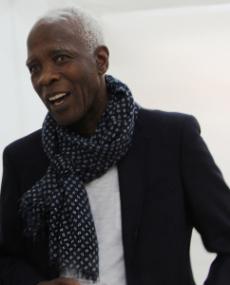
Kay Hassan was born in the Johannesburg township of Alexandra in 1956. His mother brewed traditional beer at a shebeen, defying apartheid laws and repeated raids by police. His cousin, William Shibambo, worked as artist on a part-time basis. Painting and drawing images classified as ‘township art’ inspired Hassan to become an artist himself.
Hassan first pursued his interest in art by working with Matsemela Manaka and his Creative Youth Association (CYA). The organisation provided participants with a studio to explore their interests in theatre, music and poetry, as well as visual art. At one point, Hassan designed anemblem for the Creative Youth Association which was featured in the November/December issue of Staffrider magazine in 1979.
Eventually tiring of the CYA environment, Hassan enrolled in art classes at the Arts and Crafts Centre at Rorke’s Drift in 1978. Here, he worked on his skills in sculpture and pencil drawings, among other media. He met many other artists, including Dumisani Mabaso, Pat Mautloa and Sam Nhlengethwa. He used some of the skills learned at Rorke’s Drift to teach others in his community, coaching his cousin and CYA members in printmaking, woodcuts and painting. After some time away from the school, he returned to finish his arts and crafts certificate in 1980. Later, he participated in a group exhibition at the Pretoria Art Museum. In 1981, Hassan participated in a group exhibition at the Africa Centre in London.
In the 1980s, Hassan worked as part of the group Art in Motion, abbreviated Artimo. The organisation devoted itself to the promotion of work by black artists, staging exhibitions in Britain and South Africa. He also studied at Bill Ainslie’s Johannesburg Art Foundation.
Hassan largely evaded a dependency on gallery sales in order to escape the formulaic style expected of black artists at the time. He sought freedom to experiment and cultivate his own artistic inclinations through earning an income distributing Staffrider magazines, selling his work at open exhibitions in Soweto and making portraits of people in his community.
Hassan exhibited at the Bradford Print Biennale in 1983. The French government awarded him a scholarship to study printmaking with S.W. Hayter at Studio 17 in Paris from 1986 to 1988. Despite the accolades for his prints, Hassan became better known for his paintings, collages and installation works.
After his tenure at Studio 17, Hassan studied at the Schule fur Gestaltung (School of Design) in Basel, Switzerland and held a solo exhibition there in 1989. In 1990 he returned to South Africa to teach at the Federated Union of Black Artists (FUBA). He became a teacher at the Alliance Française in Soweto and participated in Thupelo Art Project workshops in 1985 and 1989.
Like fellow Rorke’s Drift alumnus Sam Nhlengethwa, Hassan worked in collage to depict scenes of political and social import. In 1994, Hassan started acquiring unused billboard advertising sheets from printing companies to make what he called paper constructions. A profile by Rory Bester in the Spring/Summer 1999 Journal of Contemporary African Art quoted Hassan saying, ‘People spend a lot of time waiting for transport and they are forced to become familiar with the billboard images they pass every day. I’d love to install my paper constructions on these billboard sites at train stations and bus stops, so that instead of people having to look at beer advertisements they can see an artist's image that speaks to them.’
Working on a large scale, he created multimedia images in a painterly style, depicting scenes of voting queues and commuters packed in minibuses. ‘I suppose this is part of the seduction,’ he said, according to Rory Bester. ‘Viewers are seduced by the fact that from far away the paper constructions look like paintings, but up close its clear that they’re constructions.’ Hassan also collaborated with the painter Patrick Mautloa on installation projects during the early 1990s.
Since the 1980s, Hassan has exhibited his works throughout South Africa and abroad, in New York, Minneapolis, Gwangju, UmeÁ¥, Rome, Munich and Cologne. His work was included in the 1997 Johannesburg Biennale, and in 2000 he became the first recipient of the DaimlerChrysler award for South African Contemporary Art, along with its R300 000 prize. In recognition of the latter achievement, artist David Koloane noted that Hassan’s work ‘is not angst ridden nor is it vengeful or unfeeling ... It brings to [its] audience a quest for human understanding and reflects Kay’s profound feeling for humankind’. A critique of his New York City exhibition at the Jack Shainman Gallery in 2008 noted that Hassan’s ‘Mozambique Series’ ‘can be understood as part of a lineage that includes muckraking photojournalism’. In 2008, Hassan was given a mid-career retrospective exhibition at the Johannesburg Art Gallery. Hassan held a solo show at the Shainman gallery titled ‘Everday People’ in 2014, in addition to participating in several group exhibitions and the 2015 Venice Biennale.
In the 1990s, Hassan began working at the Bag Factory Studios in Johannesburg (formerly known as the Fordsburg Artists’ Studios), collaborating with other artists such as Sam Nhlengethwa, Pat Mautloa and David Koloane. His works are included in the collections of the National Gallery of Canada in Ontario, the Walker Art Center in Minneapolis, the High Museum in Atlanta, and the National Museum of African Art at the Washington, D.C. Smithsonian Institution, the Walther Collection in New York, and the Daimler Art Collection in Berlin.